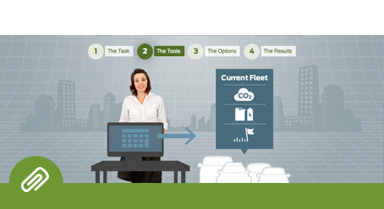Sustainability Report 2013/14
Climate Change and the Environment
We have comprehensive strategies and goals for minimizing our environmental impacts, including reducing our contribution to climate change.
Read more about our approach to climate change and the environment
Climate Change Strategy
Ford has a science-based strategy to reduce greenhouse gas (GHG) emissions from our products and operations that focuses on doing our share to stabilize carbon dioxide (CO2) concentrations in the atmosphere.
Read more about our strategy, commitment and progress
Our Goals and Performance Progress
Goal: For each of our new or significantly refreshed vehicles, continue to offer a powertrain with leading fuel economy.
We reduced the average CO2 emissions of our European car fleet by 18% between 2007 and 2013. In the U.S. in 2013, we improved the average fuel economy of our car fleet by 2% and of our truck fleet by 3% compared with 2012.1
Goal: Reduce CO2 emissions from our facilities by 30% per vehicle produced from 2010 to 2025.
In 2013, we reduced facilities CO2 emissions per vehicle produced by 9% and average energy consumed per vehicle produced by 4% compared with 2012.
Goal: Reduce waste sent to landfill by 40% on a per-vehicle basis between 2011 and 2016 globally.
We reduced waste to landfill per vehicle produced by 14% in 2013 compared with 2012.
Sustainable Technologies and Alternative Fuels Plan
Our sustainable technologies and alternative fuels plan is our route to improving fuel economy and cutting the CO2 emissions of our products around the world. We have already implemented all of the near-term and many of the mid-term elements of this plan.
Read more about our Sustainable Technologies and Alternative Fuels Plan
Case Study: Helping Fleet Customers Meet Environmental and Cost Goals
We have developed a suite of purchasing tools to help fleet customers understand the most cost-effective ways to reduce the carbon emissions of their vehicle fleets, helping them meet environmental and financial goals simultaneously.
Voice: John Fleming
Executive Vice President, Global Manufacturing and Labor Affairs, Ford Motor Company
“When we consider building a new plant, we look at the same issues no matter where we are thinking of locating the facility – air emissions, water usage, waste water and waste. But of course the emphases may vary depending on the local conditions.”
Electrification
We are taking a comprehensive approach to electrified vehicles (EVs). We have introduced six EV products. We are developing a suite of customer support tools such as charging station locaters and fuel-efficiency tracking apps and working with utilities, cities and other partners to develop an electrified vehicle ecosystem that facilitates the adoption and use of EVs.
Read more in Electrification: A Closer Look
2013 Highlights
114 million + all-electric miles driven by Ford full battery electric vehicles (BEVs) and plug-in hybrid electric vehicles (PHEVs) customers so far, resulting in an 8 million kg reduction in CO2 compared to gasoline-powered miles.
100% of Ford vehicles produced in North America have used soy foam seating since 2011.
- Our U.S. combined car and truck corporate average fuel economy decreased by 1.7% in 2013 due to increased customer demand for trucks versus cars.
© 2014 Ford Motor Company






